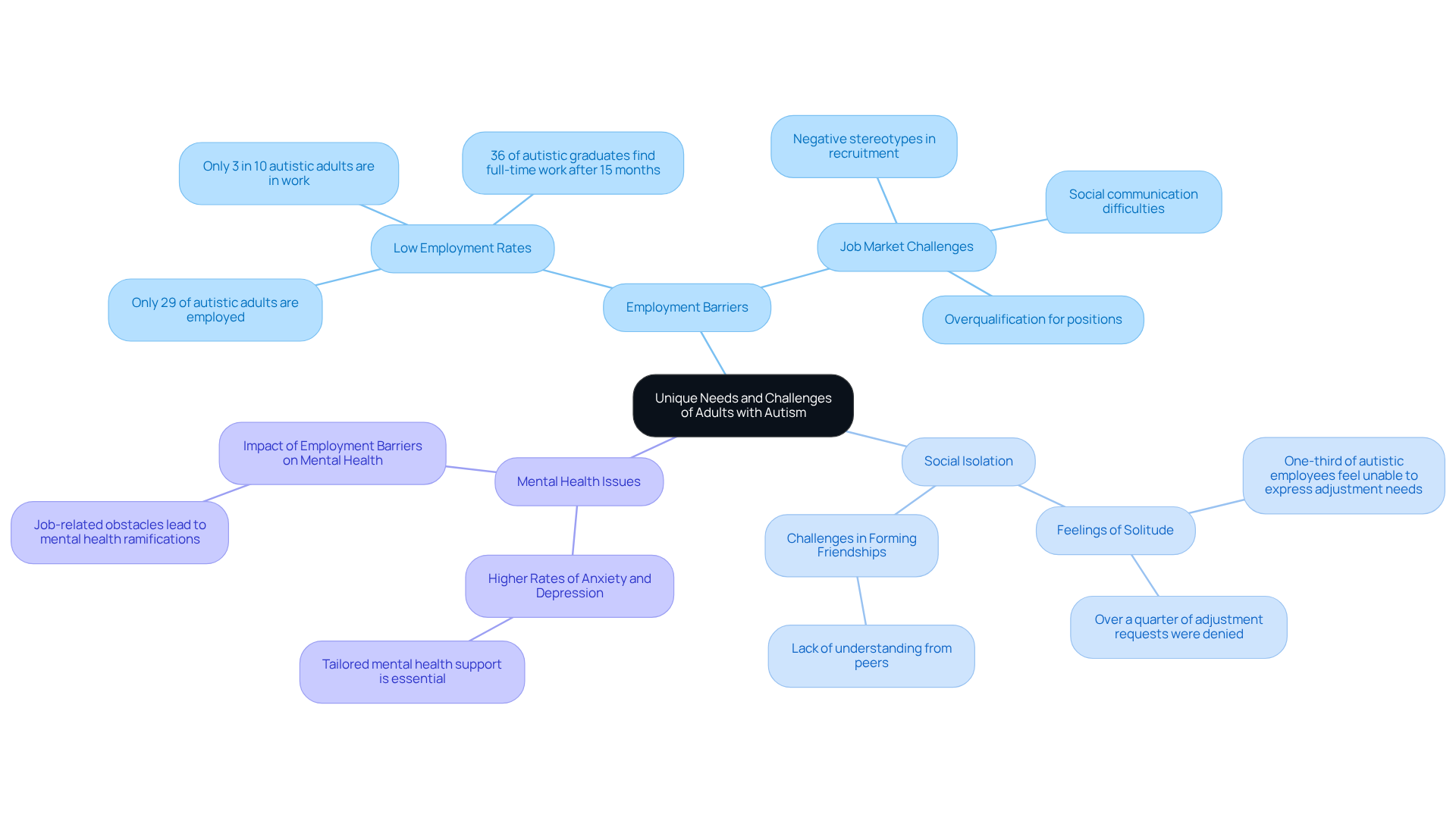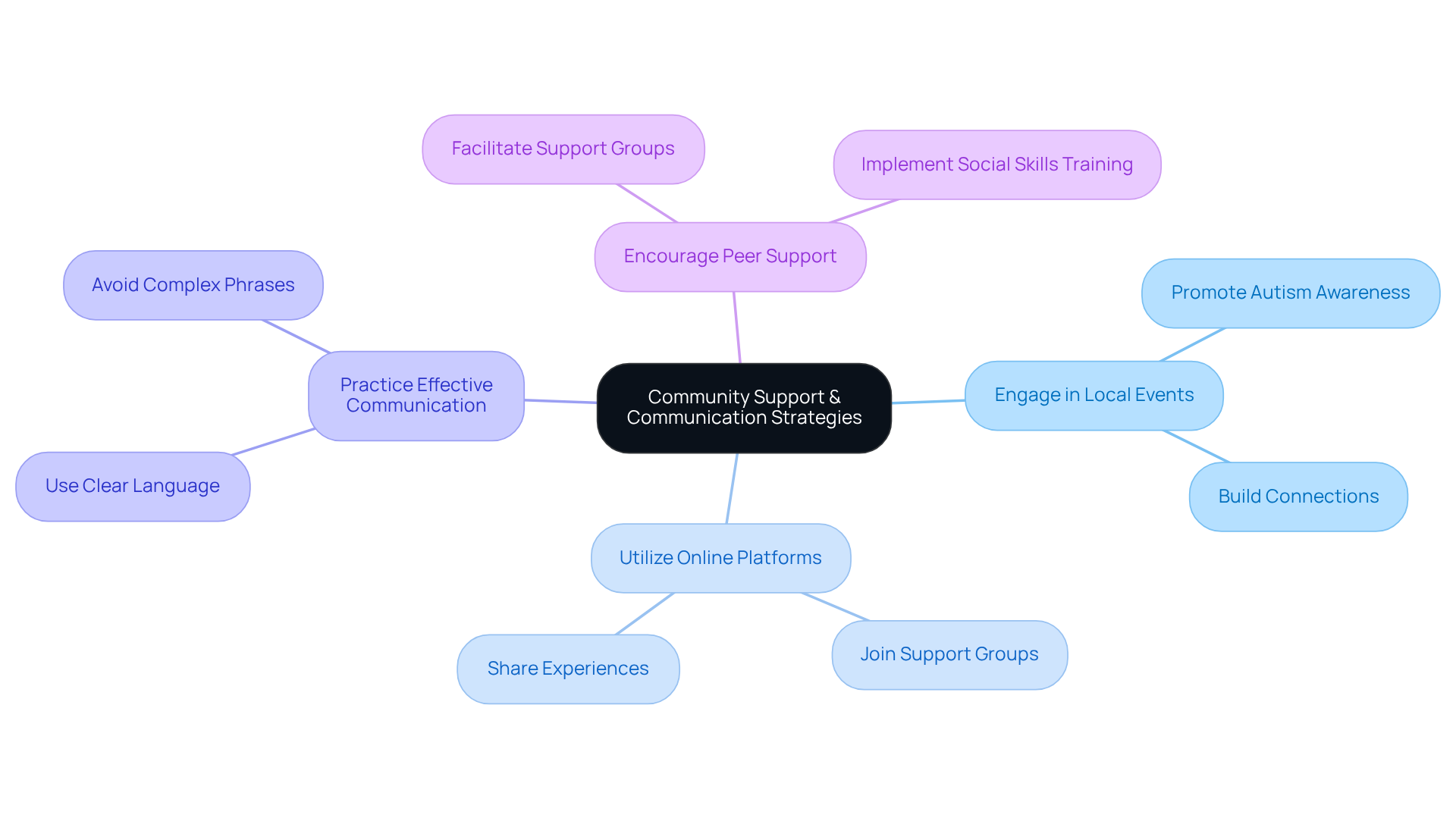Overview
This article centers on understanding the needs of adults with Autism Spectrum Disorder (ASD) and finding resources to support them. It highlights the importance of recognizing the unique challenges they face, such as:
- Difficulties in social communication
- Barriers to employment
By grasping these challenges, we can develop tailored assistance and effective support services that truly enhance their quality of life. Together, let's explore how we can make a difference in their journey.
Introduction
Understanding Autism Spectrum Disorder (ASD) in adults unveils a landscape filled with unique challenges that can deeply affect their daily lives. Communication barriers and social isolation often persist, making the need for targeted resources and support increasingly vital.
How can individuals and families navigate the complexities of autism to enhance quality of life and cultivate meaningful connections? This article explores the specific needs of adults with autism, offering valuable insights into available resources and strategies to build a nurturing community.
Understand Autism Spectrum Disorder in Adults
Autism Spectrum Disorder (ASD) is a complex neurodevelopmental condition that significantly impacts how individuals communicate, interact, and perceive their environment. For adults with ASD, social communication can present unique challenges that warrant understanding and help for adults with autism.
- Understanding Social Cues: Many adults with autism find it difficult to interpret non-verbal signals, such as body language and facial expressions. This can make social interactions feel overwhelming. Notably, the CDC reports that boys are diagnosed with autism spectrum disorder (ASD) at a rate four times higher than girls, underscoring the importance of tailored communication strategies.
- Maintaining Conversations: Initiating and sustaining conversations can be a hurdle, often leading to misunderstandings or awkward pauses that hinder relationship-building. Research indicates that approximately half of young individuals with autism in the U.S. were not employed or enrolled in college within the first two years after high school, complicating their social interactions further.
- Forming Relationships: Establishing and nurturing personal connections can be particularly challenging due to difficulties in understanding social norms and expectations. Steven Zauderer, CEO & Founder of CrossRiverTherapy, notes that "individuals on the autism spectrum have been shown to communicate much more effectively with fellow individuals on the autism spectrum than with non-autistic individuals."
In addition to these communication hurdles, adults with autism may also exhibit:
- Repetitive Behaviors: Engaging in repetitive movements or routines can provide comfort and predictability in their daily lives.
- Sensory Sensitivities: Many individuals experience heightened or diminished sensitivity to sensory inputs, such as sounds, lights, or textures, which can further complicate social interactions.
Research indicates that effective communication strategies tailored to the unique needs of autistic individuals can serve as help for adults with autism, significantly enhancing their social skills and overall quality of life. For instance, psychologists emphasize the importance of creating encouraging environments where individuals with developmental disorders can engage in social interactions safely. Real-world examples show that with the right resources and support, many individuals on the autism spectrum can improve their communication abilities and build meaningful relationships.
Understanding these traits is essential for developing focused assistance and resources, such as help for adults with autism, that address the specific needs of individuals on the autism spectrum. Comprehensive insights into ASD can be found through various organizations dedicated to awareness and support, such as the CDC and Autism Speaks. Together, we can foster a more inclusive community that embraces and supports individuals with ASD.

Identify Unique Needs and Challenges of Adults with Autism
The unique needs and challenges faced by adults with autism profoundly affect their quality of life, underscoring the importance of help for adults with autism.
- Employment Barriers: It is disheartening to note that only 3 in 10 autistic adults are employed, a staggering contrast to the 80% employment rate of non-disabled individuals. Many individuals on the spectrum encounter difficulties in securing and maintaining jobs due to social communication challenges and workplace dynamics. Autistic graduates are particularly vulnerable; they are the least likely to hold permanent roles, with only 36% finding full-time work after 15 months, often feeling overqualified for their positions.
- Social Isolation: The lack of understanding from peers often leads to feelings of solitude and separation, making it challenging for individuals on the spectrum to form meaningful friendships. Reports suggest that around one-third of autistic employees feel unable to express their adjustment needs, and over a quarter of those who sought adjustments were denied, further deepening their sense of isolation.
- Mental Health Issues: The reality is that autistic adults experience higher rates of anxiety, depression, and other mental health conditions. Tailored mental health support is essential, as these individuals navigate a complex landscape of emotional and psychological challenges, which emphasizes the importance of help for adults with autism. As Mel Merritt from the National Autistic Society emphasizes, significant effort is necessary to ensure that individuals on the spectrum can obtain suitable employment that aligns with their skills and needs, highlighting the mental health ramifications of job-related obstacles.
Addressing these challenges is vital for providing help for adults with autism. Resources and community initiatives play a crucial role in fostering understanding and creating opportunities for autistic individuals to flourish. Together, we can make a difference.

Locate Resources and Support Services for Adults with Autism
Finding the right resources and support services for adults with autism can feel overwhelming, but following these thoughtful steps can make the process easier and more effective:
-
Research Local Organizations: Start by exploring local autism organizations that offer tailored resources for individuals. Groups like the Autism Society and AANE serve as excellent initial points of contact for help for adults with autism by providing a wide range of assistance services designed to meet specific needs.
-
Utilize Online Resource Directories: Comprehensive online directories, such as those provided by Autism Speaks, showcase essential services, including employment assistance, housing support, and community programs specifically for individuals on the autism spectrum. With about 1 in 45 adults in the U.S. estimated to have autism, accessing help for adults with autism is vital for enhancing their quality of life.
-
Connect with Assistance Groups: Engaging with assistance groups can create valuable connections and shared experiences. Platforms like Meetup or local community centers often host gatherings that cater to the needs of individuals on the autism spectrum and their families. Remember the words of Senator Tom Harkin: "Autism is not a tragedy. It's a challenge that can be met with creativity, courage, and resolve."
-
Consult Healthcare Providers: Healthcare professionals can play a crucial role in recommending local resources and assistance services that provide help for adults with autism and align with their unique needs. They can help navigate the complexities of available services, ensuring individuals receive the support they require.
By following these steps, individuals and families can more effectively navigate the resources available to them, ensuring they access the assistance necessary for a fulfilling life. At ASD Media, we are committed to providing valuable resources and support for individuals on the spectrum, empowering families to realize their potential.

Build Community Support and Effective Communication Strategies
To foster community support and enhance communication for adults with autism, let’s explore some compassionate strategies:
- Engage in Local Events: Participating in community events or workshops focused on autism awareness can be a wonderful way to meet others and build connections. With 1 in 36 U.S. children diagnosed with ASD, these gatherings play a crucial role in promoting understanding and assistance.
- Utilize Online Platforms: Joining online forums and social media groups dedicated to supporting individuals with developmental disorders, such as those found on Facebook or Reddit, can serve as vital resources. These platforms allow for the sharing of experiences and the formation of community bonds.
- Practice Effective Communication: When interacting with individuals on the spectrum, using clear and direct language is essential. Avoid idioms or complex phrases that may lead to confusion. As Jane Miller wisely states, "Identifying the key signs of autism masking can aid in offering improved assistance for individuals with autism."
- Encourage Peer Support: Facilitating opportunities for individuals on the spectrum to connect through support groups or social skills training programs can be incredibly beneficial. A case study on the "Impact of ABA Therapy on Classroom Success" illustrates how community engagement can lead to positive outcomes for autistic individuals.
These strategies can help for adults with autism by creating a more inclusive community and improving communication, ultimately enhancing their quality of life. By aligning these efforts with ASD Media's mission of fostering collaboration and growth in the ABA therapy industry, we can ensure that our initiatives are impactful and supportive.

Conclusion
Understanding the intricacies of Autism Spectrum Disorder (ASD) in adults is crucial for fostering a supportive environment that addresses their unique challenges. It is vital to recognize communication barriers, social isolation, and the specific needs of adults with autism. By identifying these factors, individuals and families can seek targeted resources and support services that significantly enhance the quality of life for those on the spectrum.
Key insights underscore the need for tailored communication strategies, community involvement, and effective resource navigation. The staggering statistics regarding employment barriers and mental health issues faced by autistic adults reveal a pressing need for comprehensive support systems. From local organizations to online resource directories, a wealth of assistance is available, enabling individuals to build meaningful connections and improve their social skills.
Ultimately, the journey toward a more inclusive community rests on collective effort and understanding. By actively engaging with available resources, advocating for the needs of adults with autism, and fostering supportive networks, society can help bridge the gap that often isolates these individuals. Embracing the challenge of autism with compassion and creativity not only enriches the lives of those affected but also cultivates a more empathetic and connected world.
Frequently Asked Questions
What is Autism Spectrum Disorder (ASD)?
Autism Spectrum Disorder (ASD) is a complex neurodevelopmental condition that significantly impacts how individuals communicate, interact, and perceive their environment.
What are some communication challenges faced by adults with ASD?
Adults with ASD often have difficulty interpreting non-verbal signals, maintaining conversations, and understanding social norms, which can hinder their ability to build relationships.
How does the diagnosis rate of ASD differ between genders?
The CDC reports that boys are diagnosed with autism spectrum disorder at a rate four times higher than girls.
What is the employment status of young individuals with autism after high school?
Research indicates that approximately half of young individuals with autism in the U.S. were not employed or enrolled in college within the first two years after high school.
How do adults with ASD form relationships?
Establishing and nurturing personal connections can be particularly challenging for adults with ASD due to difficulties in understanding social norms and expectations. They may communicate more effectively with others on the autism spectrum than with non-autistic individuals.
What are some common behaviors exhibited by adults with autism?
Adults with autism may engage in repetitive behaviors for comfort and predictability and experience sensory sensitivities to inputs such as sounds, lights, or textures.
How can communication strategies help adults with autism?
Tailored communication strategies can significantly enhance the social skills and overall quality of life for adults with autism, enabling them to engage in social interactions more effectively.
What resources are available for understanding ASD?
Comprehensive insights into ASD can be found through organizations dedicated to awareness and support, such as the CDC and Autism Speaks. These resources aim to foster a more inclusive community for individuals with ASD.




